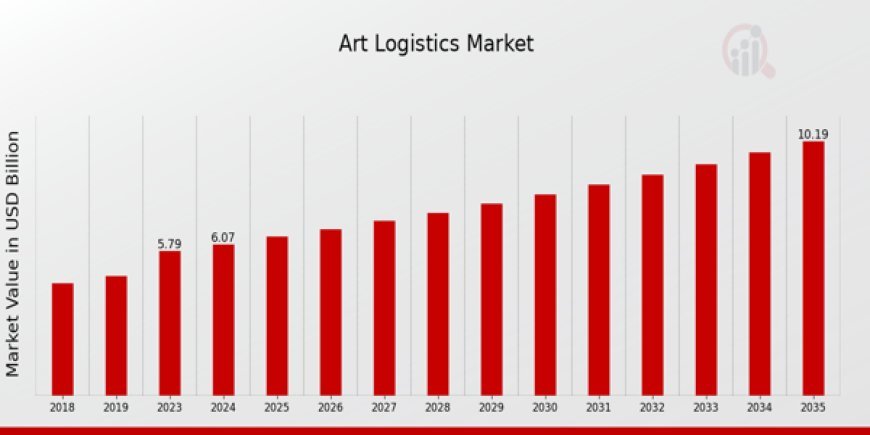The Role of Technology in Transforming the Art Logistics Industry

Introduction
The art logistics market plays a crucial role in the global art industry by facilitating the transportation, storage, and handling of valuable artworks. This specialized sector ensures that paintings, sculptures, antiques, and other fine art pieces are securely moved from one location to another while maintaining their integrity and value. As the art world becomes increasingly globalized, auction houses, museums, and private collectors are relying more on professional logistics services to manage their assets efficiently.
Market Overview
Over the past decade, the art logistics market has witnessed steady growth, primarily driven by rising art investments, expanding international art fairs, and advancements in logistics technologies. According to industry estimates, the global art logistics market is projected to grow at a compound annual growth rate (CAGR) of approximately 6-8% over the next five years. Furthermore, the market is segmented into key service areas, including transportation, packaging, storage, and additional services such as insurance and customs clearance.
Key Market Drivers
Several factors are propelling the growth of the art logistics market.
-
Growing Art Investments
The art market has been expanding, with increasing investments in fine art as an asset class. As a result, high-net-worth individuals and institutions are acquiring valuable art pieces, necessitating professional logistics services to ensure their safe handling and transport. -
Rising Number of Art Exhibitions and Fairs
With the proliferation of international art fairs such as Art Basel and Frieze, there is a higher demand for logistics companies that specialize in transporting artworks across borders. This increase in exhibitions directly influences the need for secure and reliable logistics solutions. -
Technological Advancements
Innovations in tracking, climate control, and security measures have significantly improved the efficiency and reliability of art logistics. These advancements help mitigate risks associated with theft, damage, or environmental changes, thereby increasing confidence in the logistics process. -
Stringent Regulatory Requirements
Governments and international organizations impose strict regulations on the transportation of cultural artifacts. Consequently, art logistics firms must have the expertise to comply with these legal frameworks, making professional services essential in the industry.
Market Segmentation
To better understand the art logistics market, it is essential to analyze its segmentation by service type and end-user.
-
By Service Type:
-
Transportation: Includes air, sea, and land transport solutions tailored to art pieces.
-
Packaging: Specialized materials and techniques designed to protect fragile and valuable artworks.
-
Storage: Climate-controlled facilities that maintain artworks under optimal conditions.
-
Other Services: Includes insurance, authentication, restoration, and customs clearance services.
-
-
By End-User:
-
Museums & Galleries: Require logistics services for exhibitions and permanent collections.
-
Auction Houses: Handle high-value transactions that necessitate secure transportation.
-
Private Collectors: Individuals with extensive collections who need specialized logistics.
-
Art Dealers & Artists: Need logistics for sales, exhibitions, and trade shows.
-
Challenges in the Art Logistics Market
Despite its growth, the art logistics market faces several challenges that must be addressed.
-
High Costs
Due to the specialized nature of handling, packaging, and security measures, art logistics services are often expensive. This cost can be a significant barrier for smaller galleries or emerging artists. -
Risk of Damage and Theft
Even with advancements in security, the risk of theft, loss, or damage remains a major concern. Given the high value of artworks, they remain an attractive target for criminals. -
Complex Regulatory Environment
International art logistics involves navigating various customs laws, taxation policies, and cultural heritage protection laws. As a result, logistics companies must be well-versed in these regulations to ensure compliance. -
Environmental Concerns
The carbon footprint of art transportation, especially air freight, has led to increased scrutiny. Consequently, there is a growing demand for more sustainable solutions in art logistics.
Emerging Trends
Looking ahead, several key trends are shaping the future of the art logistics market.
-
Digitization & Blockchain Technology
The use of blockchain for provenance tracking and digital documentation is becoming more prevalent, enhancing security and transparency in the art logistics market. -
Sustainable Art Logistics
Companies are increasingly exploring eco-friendly packaging materials, optimizing transportation routes, and using electric or hybrid vehicles to reduce environmental impact. -
Rise of Art Storage Services
With more investors purchasing art as a financial asset, there is a heightened demand for secure and climate-controlled storage facilities. -
Increased Use of AI and IoT
Artificial Intelligence (AI) and the Internet of Things (IoT) are being integrated into logistics solutions for real-time monitoring of environmental conditions and location tracking.
Key Players in the Market
Several companies dominate the art logistics market, providing specialized services tailored to high-value artworks. Notable players include:
DHL
A1 Art Logistics
Gander
K. Fine Arts
Helly Nahmad Gallery
UPS
UOVO
Art Logistics
FedEx
Crated
Bureau Veritas
Sotheby's
Rijksmuseum
Floydand Associates
-
Regional Insights
The art logistics market varies across different regions, with some areas demonstrating stronger growth than others.
-
North America
The U.S. and Canada have a well-established art logistics market, driven by major auction houses such as Sotheby’s and Christie’s. -
Europe
Countries like the UK, France, and Germany are significant players due to their rich art heritage and vibrant gallery scene. -
Asia-Pacific
China, Japan, and South Korea are experiencing a rise in art investments, leading to increased demand for logistics services. -
Middle East & Africa
Dubai has emerged as a major art hub, contributing to regional growth in the art logistics sector.
Future Outlook
The art logistics market is poised for steady growth, with increasing digital transformation, sustainability initiatives, and security innovations shaping the industry’s future. Companies that invest in technology-driven solutions and eco-friendly practices will gain a competitive edge. Additionally, collaboration between art logistics firms, insurers, and technology providers will enhance service efficiency and reliability.
Conclusion
In conclusion, the art logistics market is an indispensable part of the global art industry, ensuring the safe transportation and preservation of valuable artworks. As art investments continue to rise and technological innovations improve service quality, the market is set for sustained growth. However, challenges such as regulatory complexities and environmental concerns must be addressed to optimize operations and meet the evolving needs of art collectors, galleries, and museums worldwide.
What's Your Reaction?



























































